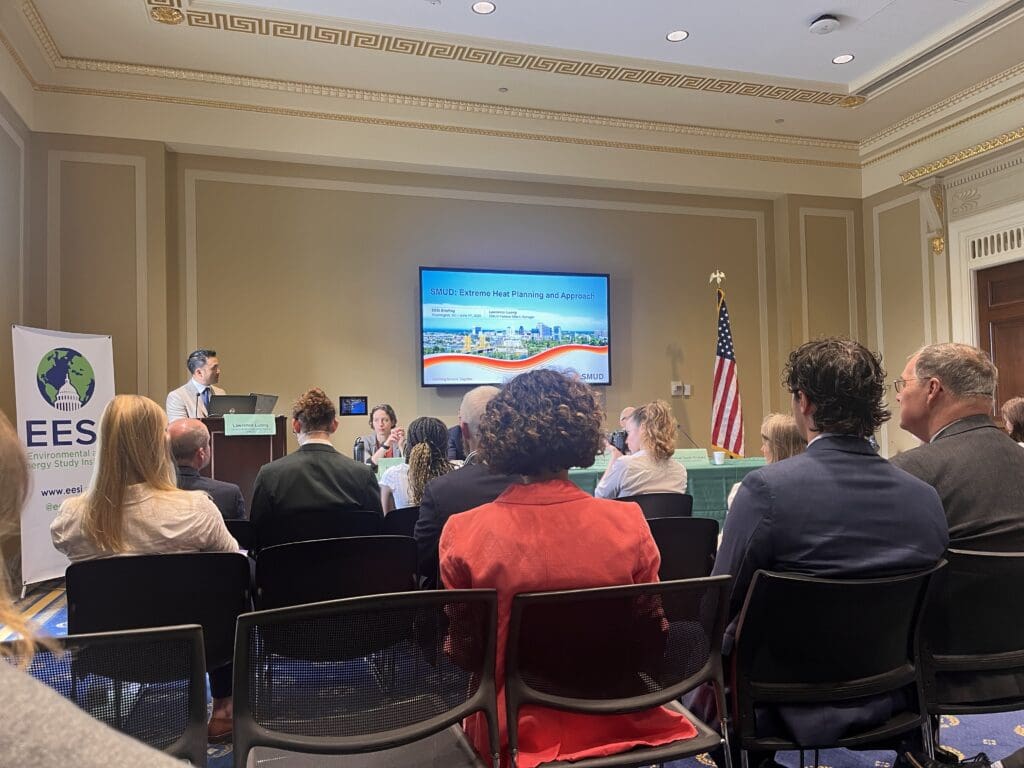In June, Bio4Climate Science Communications Intern Adrianna Drindak attended a congressional briefing in Washington, D.C., by The Environmental and Energy Study Institute (EESI) and the Federation of American Scientists about how federal policies can bolster resilience to extreme heat at the state and community level, centered on the Federation of American Scientists’ 2025 Heat Policy Agenda.

The hottest temperatures of the year are hitting the central and eastern United States this week. Heat records are being broken in major cities within these regions, left and right. Which begs the question – how do we adapt to extreme heat, and what solutions are out there to mitigate future effects? I recently attended a briefing hosted by the Environmental and Energy Study Institute (EESI) and the Federation of American Scientists (FAS) in Washington, D.C, titled Beating the Heat: A 2025 Heat Policy Agenda. The goal of this conversation was to talk about extreme heat and what we can do about it on local, city, state, and federal scales.This briefing brought in speakers from various facets of the extreme heat conversation to gather perspectives on what actions are currently being taken and what the next steps are for mitigating the effects of extreme heat.
A common thread throughout these presentations is the role of natural shade and cooling in communities:
- Dr Hannah Stafford, the Associate Director of Climate and Environment at FAS, discussed the 2025 Heat Policy Agenda, which included recommendations such as investments in urban and community forestry.
- Dr. David Hondula, Director of the Office of Heat Response and Mitigation in the City of Phoenix, Arizona presented the Phoenix Shade Plan, which involves planting trees for local shade within the city.
- Dr. Leo Bachinger, Bureau Chief in the Office of Climate Change at the New York State Department of Environmental Conservation, highlighted a recent extreme heat action plan that involves support for green infrastructure and ecosystem-based adaptation.
- Hannah Smith-Brubaker, the Executive Director of Pasa Sustainable Agriculture, emphasized the role of natural systems, such as trees and streams, as a way for farm workers to cool off during the work day. She also mentioned silvopasture, which involves planting trees in pastures to increase shade for farm animals.
- Lawrence Luong, the Federal Affairs Manager at the Sacramento Municipal Utility District, introduced about a free shade program, which provides free trees to customers.
These perspectives are important, but there is some essential science that is missing from this conversation.
Trees can provide shade, yes, but when working together in a forest ecosystem, they can create cooling, from the moisture in the living soil to the transpiration of every leaf. Protecting a livable climate for all requires us to tackle the systemic causes of climate change, not just the symptoms and localized effects. We need a cooler climate, not just a cooler city block. Wetlands, forests, soils, and the biodiversity of these ecosystems regulate temperature and contribute to local cooling that extends beyond shade through their roles in the water cycle. Adaptation alone is not a solution, and even as a bandaid is only temporary as natural systems continue to break down further year after year, absent real action.
We must support these essential ecosystems that are drivers of natural cooling around the world, especially since these habitats continue to be destroyed for industrial agriculture and by land degradation. And they have to be a part of the conversation. The speakers discussed methods such as urban forestry and tree planting. This is a great start, but we’ve got to take it further. How could native Miyawaki forests fit into this conversation? What if instead of just planting trees, we looked to support other natural cooling systems by rewetting degraded lands, reconnecting waterways, and restoring local climate conditions?
Throughout the event, there was an emphasis on how just having people in a room to talk about these topics and bring extreme heat to the forefront of the conversation is momentous for the field. In 2023, extreme heat in the United States impacted 65 million people, a number that is sure to rise as global temperatures continues to swell from greenhouse gas emissions and human-disrupted feedback systems. While it is important to identify ways to survive the present conditions, that is not a long-term solution to limiting the effects of extreme heat. We must target the source of extreme heat, which lies with our carbon emissions and disrupted ecosystems, to work towards a cooler future. And that HAS to be a part of every heat mitigation briefing, conversation, and agenda.

Adrianna Drindak is a rising senior at Dartmouth College studying Environmental Earth Sciences and Environmental Studies. Prior to interning at Bio4Climate, she worked as a field technician studying ovenbirds at Hubbard Brook Experimental Forest and as a laboratory technician in an ecology lab. Adrianna is currently an undergraduate researcher in the Quaternary Geology Lab at Dartmouth, with a specific focus on documenting climate history and past glaciations in the northeast region of the United States. This summer, Adrianna is looking forward to applying her science background to an outreach role, and is excited to brainstorm ways to make science more accessible. In her free time, Adrianna enjoys reading, baking gluten free treats, hiking, and backpacking.

